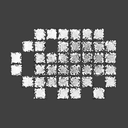Hi luriaz, welcome on this forum !
That's a handfull you're asking for. Explaing everything in depth would possibly overflow the maximum allowed length of a post  But this might get you started:
But this might get you started:
In pd arrays play an important role to store audio data (samples). You can create one from the put menu and give it a name, e.g. : myTable.
To load a sample from your disk in a table use the [soundfiler] object like this
[bang(
|
[openpanel]
|
[read -resize $1 myTable(
|
[soundfiler]
So now you have the audio in your table, there are several methods to play it back. The easiest is [tabplay~]:
[bang(
|
[tabplay~ myTable]
|\
[dac~]
Et voilà, you should hear your sample played back once. [tabread4~] is more flexible but should be used by a sample position object (e.g. [phasor~] or [line~]).
[tabwrite~] is inversely used to record audio into your table like this:
[adc~] [start( [stop(
| / /
[tabwrite~ myTable]
The fft class objects ([rfft~] [rifft~] [fft~] [ifft~] ) are used to do transformations from the time domain to the frequency domain and are usefull to perform all kinds of spectral goodness. This is no easy business, but there are some usefull examples/tutorials if you search on this forum.
Don't forget that you can ask help for (nearly) every object by right-clicking them and selecting... tadaaa : help.
Hope this helps to get you started,
Domien
PS : remember that tables are not only used to store audio data, but just any kind of numeric data (e.g. control data for a sequencer) you want to work with. These number go in exactly the same kind of tables/arrays as audio data.


 But this might get you started:
But this might get you started: